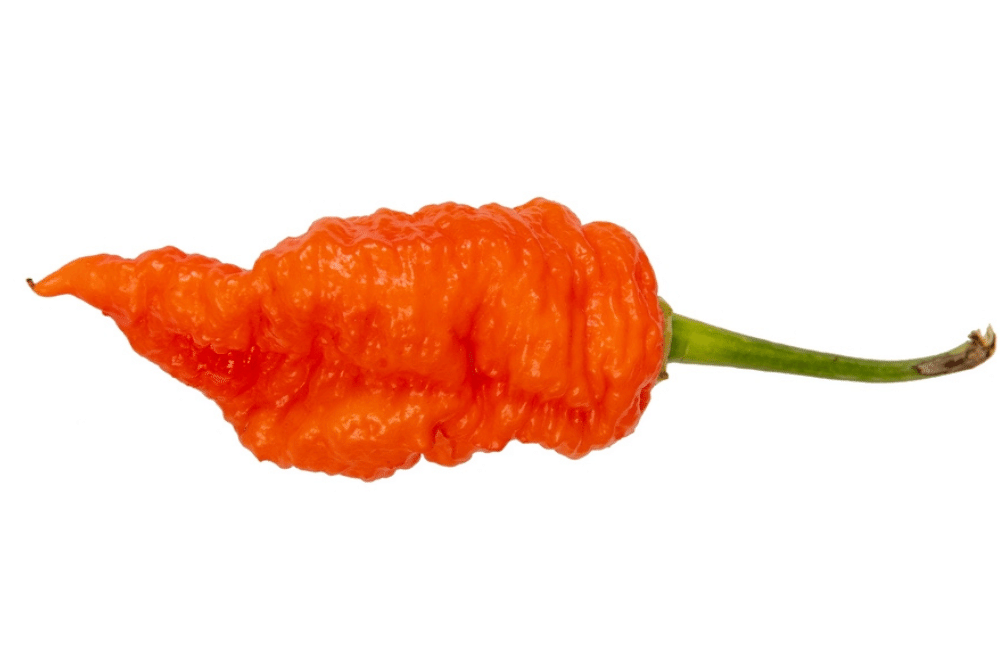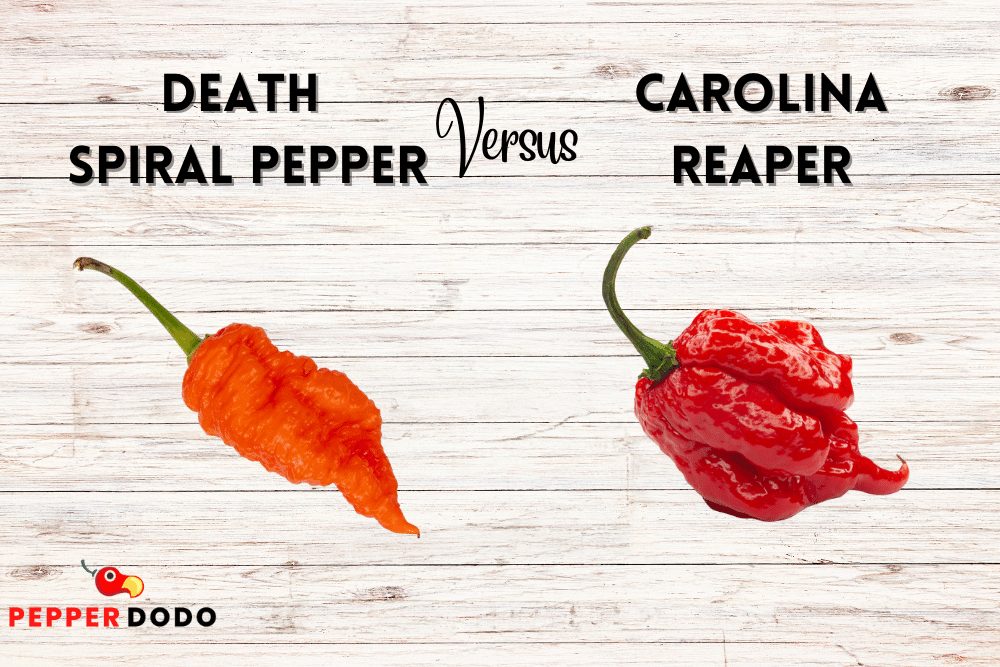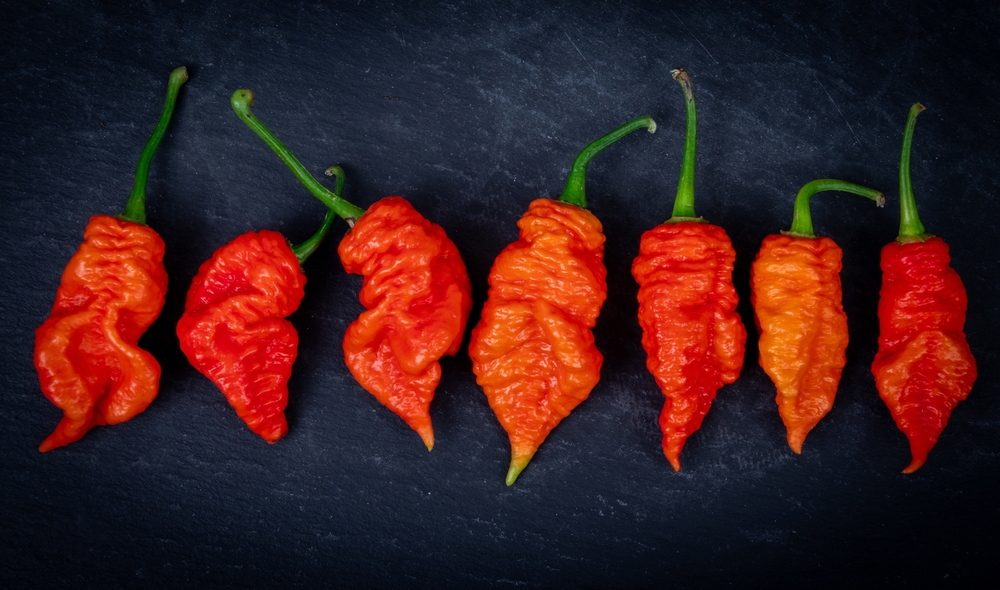Also known as death pepper, the death spiral pepper is a relatively new entrant in extremely hot chiles. It was developed in 2017 in the United Kingdom, and since then, death spiral pepper has won the hearts of hot pepper lovers. This scorcher is closely following the Carolina reaper pepper in terms of popularity.
What Are Death Spiral Peppers?
Death spiral peppers are chiles first discovered in 2017 by Jim Duffy after planting capsicum seeds he bought from a U.K. grower, Terry Smith.
The chiles are a variant of the Naga bubblegum Red Cross variety, known for hot peppers that burn your taste buds. Like other Naga types, the pepper has a wild flavor.
The death spiral peppers have a scary appearance with a variable size. They are a member of the capsicum chinense species, which consists of extremely hot chiles. Like other hot peppers, they have a unique, three-stage ripening process characterized by color changes in every stage. Due to its fast germination and bumper harvest, pepper growers love this deadly pepper.
Beneath the bumpy skin lies a unique floral, fruity and citrusy flavor great for various cuisines—if you can get past the extreme heat!

Due to the high capsaicin concentration in these chiles, you may enjoy health benefits, including fighting colon cancer, curbing asthma, and managing sore throat and leukemia.
Are Death Spiral Peppers The Hottest Peppers?
No. Death spiral peppers are super-hot (1,000,000-1,300,000 SHUs), but not the hottest. The Carolina reaper still currently holds the Guinness Book of Records title of the world’s hottest pepper.
Carolina reaper ranges between 1,641,000-2,200,000 SHUs on the Scoville scale. It will light up your dishes—and your mouth.
However, be cautious when ingesting scorching peppers. A PubMed Central study found an esophageal rupture in a respondent after eating an ultra-spicy pepper. Other uncomfortable symptoms associated with eating super-hot peppers include burning mouth, nose and ears, headaches, upset stomach, diarrhea, and vomiting.
Death Spiral Peppers Vs. Carolina Reaper Peppers
While the two peppers come from capsicum chinense species, they are different peppers:
Heat level (SHU): Death spiral pepper ranges from 1,000,000-1,300,000 Scoville heat units on the Scoville scale, while Carolina reaper tops the list of ultra-hot peppers with 1,641,000-2,200,000shus.
Color: Death pepper has a unique color variation through the ripening process. It starts with light green, to peach, then orange and finally red when fully ripened.
Carolina reapers are green when unripe before changing to yellow, chocolate, peach, orange, caramel or red, depending on specific varieties. The original, common Carolina starts green and turns red on maturity.
Size: Death spiral peppers and Carolina reapers are similar-sized, about 2-3 inches.
Texture: Death spirals have bumps with wrinkled, brain-like patterns on the skin and pointed tail-like tips. Conversely, the reaper peppers present gnarled, smooth, bumpy texture and tipped ends.
Taste/flavor: The death peppers produce a fruity, citrusy, floral taste, whereas Carolina reapers start with a sweeter fruity flavor before a major burst of heat.

How To Use Death Spiral Peppers
Despite the extreme heat level, pepper fans use this super hot pepper in regular cooking.
Death spiral peppers are rare to find, so it’s best to grow your own at home if you want to try them in your favorite cuisines.
The most common uses of death spiral peppers include:
Super-hot sauces – use death spiral peppers instead of habanero peppers to give your Trinidadian hot pepper sauce a real heat punch.
Spicy, fresh salsas – if you like anything hot, replace the hot peppers like habanero, ghost pepper, or scotch bonnet in your salsas with death spiral chiles. Aside from the heat upgrade, they provide a fruity flavor, making them ideal for fruit salsas with mano, pineapple, or peach.
Stews and soups – add intense heat to authentic Mexican soups, like chicken tortilla and pazole.
Grilled meats, chicken, pork or fish – add diced pepper to marinades for your grilled chicken, pork or fish.
Vegeterian dishes – infuse oil with the chiles or make a compound butter to give your fresh vegetables or other vegetarian dishes a kick.
Barbeque, pasta and pizza- death spiral peppers give barbeque, pasta and pizzas a citrusy, floral flavor and serious heat.
Caution: always wear gloves and protective eyewear when handling any super-hot chili.
Where To Buy Death Spiral Peppers
Death spiral peppers are rare in grocery stores, farmer’s markets or supermarkets worldwide. Most people who love them buy death spiral pepper seeds and try growing them in home garden.
The pepper seeds come in packs and are available from online seed retailers.
Can You Grow Death Spiral Peppers?
Yes. With adequate sunlight, warm temperature and proper spacing, you can successfully grow death spiral peppers at home.
Like other capsicums, death peppers aren’t tolerant to frosty climates. The peppers do well when grown indoors before the end of last spring frost and towards the start of summer.
To get vigorous pepper plants for transplanting, ensure you use 2-6 gallon containers and start with 10% soil which you’ll increase as roots gradually develop. Depending on your region, you might get lucky in harvesting some death peppers.

